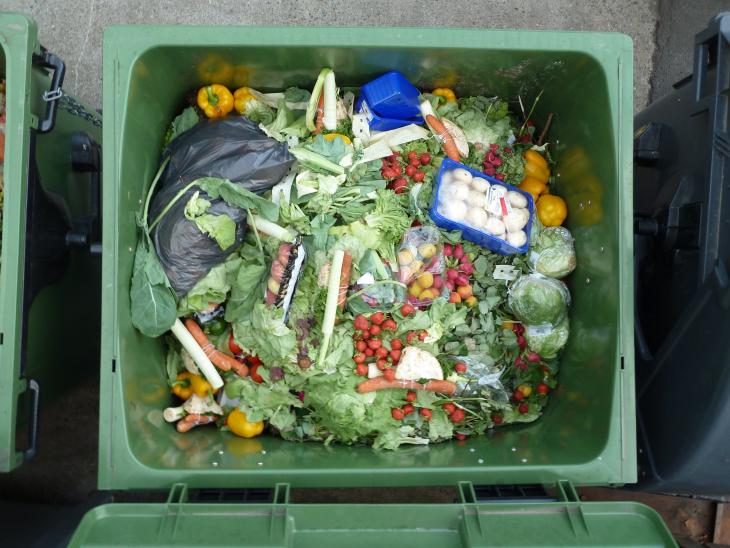A downloadable version of this lesson is available here:
Addressing the causes of food loss and waste (FLW) is an essential step toward lowering the carbon intensity, and thus increasing the sustainability, of food systems worldwide. Additionally, such consideration and efforts have the potential to positively affect difficult and pressing problems, such as global hunger and nutrition inadequacies. The United Nations (UN) has recommended a 50% reduction in FLW by 2030; however, specific strategic plans to achieve this goal are elusive. Recent research by Read et al. (2020) estimates that 16-18% of the total environmental impact of the United States' food system is caused by food that is lost or wasted. To address this critical issue, they used modeling techniques to identify critical points in the supply chain where FLW is most acute. The study highlights food processing facilities, the food service industry, and individual households as the supply chain points where FLW accrues the most, and therefore, where there could be the greatest potential gains in efficiency with systematic remediation. This lesson engages with recent FLW research and online resources to enable learners to analyze the causes of and chart potential solutions to FLW. Learners will role-play as particular food-service sector actors to advise both incremental and systematic corrections that address FLW. These critical efforts respond to the UN mandate to bring our food system toward sustainable practices in this era of increasing need for low-carbon and nutritious food pathways.
- Deconstruct the stages of the industrial food system to understand key areas of FLW.
- Critically analyze causes of food waste within the key food-service sectors of processing, retail, and consumer behavior through research and personal experience.
- Evaluate the feasibility and specific environmental impact of researched solutions related to FLW within a given sector.
- Create an interdisciplinary action plan to implement solutions within learners' communities.
-
Ask learners to imagine the following: You just plucked your favorite dairy or fruit snack from the refrigerator and saw that its “best by” date passed last week. What do you do?
Toss it in the trash; it’s spoiled.
If it’s fruit, spoon it into your personal, mostly vegan compost bin; or, if it’s dairy and you have access to a local municipal bin that can process fats, bring it there.
Open the top, assess the smell, and look for any funny colors on the surface.
Think, “That’s what stomach flora are for—last chance to dig in!”
-
Now, ask them to form informal small groups and consider the following questions:
What did you choose to do? Why?
What are the least and most environmentally sustainable behaviors? Are all actions accessible to everyone?
Name the different labels have you seen. For example, sell by, best by, consume by, etc.; do you think they have different meanings? What do you think they are?
Do you have any knowledge of regulations related to these labels?
Strategic Reductions in Food Waste (one, 75-minute class)
-
Preparatory homework: Prior to class, have learners read the study by Read et al. (2020), linked below, paying special attention to the highlighted portions, as well as the discussion and conclusion. Additionally, direct the learners to the non-profit organization ReFED to explore the website and carefully review its Roadmap to 2030.
Document -
(10 min.) To begin class, review the major insights from the homework in the lesson PPT slides below.
DocumentFood Waste.pptx (2.77 MB) -
(5 min.) Divide the class into groups of 3–4 people each and assign each group to collectively represent the role of one of the three food service sectors: manufacturing, food service, or residential. It is okay if multiple groups are working on the same target, based on the number of people in the class.
-
(15 min.) Have each group discuss the specific causes of, and challenges related to preventing food waste in their sector. This discussion should begin as a general conversation based on their experience. As residential consumers, where have they seen food waste? As restaurant customers or employees (some will have food service experience), where have they seen food waste? The third sector, manufacturing, may be less experiential, but learners may refer back to the PPT slides, the Read article, and ReFED’s Roadmap to 2030 as resources that describe causes and challenges of FLW in this sector. Learners may devote this portion of the discussion to personal experience, psychological and cultural factors to waste, household adoption of best practices including composting, and other sociological challenges that they have encountered.
-
(15 min.) Have each group create a three-column list: causes, challenges, and solutions. List 2–3 causes of waste, and pair each cause with a challenge to reduction and a potential solution. Have each group compare their solutions to those found on the ReFED Solutions Analysis page. Here, solutions are paired with data-backed estimations of potential benefits, which are broken into three categories: financial benefit, tons of waste diverted, and reductions in greenhouse gas (GHG) emissions. The group should tally their gains in each category for each solution they’ve listed. Some solutions, like reducing portion size, will show monumental gains across benefit categories. Others, like centralized compost, are quite modest in terms of money saved but show major advantages in waste diverted and GHG emissions. Groups should consider the quantitative gains expected from a given intervention versus their subjective sense of how difficult the solution would be to implement in our society. For example, portion size and centralized compost are two solutions that may encounter major challenges to implementation because of social, psychological, and economic factors.
-
(20 min.) Convene all of the participants again and ask for volunteer groups to share their cause-challenge-solution ideas, including positive environmental impact quantities, with their sociological analysis of challenges. Lead a discussion of ways that we may shift the culture of food consumption along with its technologies, industrial processes, and agricultural practices. This is the essence of a wicked problem: interdisciplinary, complicated, and working against entrenched cultural and psychological practices. Take a vote and highlight the top solution that the group finds to be the most actionable in terms of technology, culture, and provision of environmental benefit for each sector.
-
(10 min.) Have each group sketch out a local implementation strategy for this solution within their sector that would take place in their college, town, or city. As homework, have a volunteer from each group post these implementation ideas to a class discussion board.
-
Food Loss and Waste
This USDA website describes the problem of food waste and the international goal of 50% reduction of it by 2030. It also provides considerable resources, such as webinars, actionable reduction strategies for different stakeholders throughout the supply chain (e.g., farmers, businesses, individuals) and case studies of successful intervention applications.
U.S. Department of Agriculture. (n.d.). Food Loss and Waste. https://www.usda.gov/foodlossandwaste
-
Food Loss and Waste Database
This database from the Food and Agriculture Organization (FAO) of the UN provides access to thousands of data points on FLW, critical interventions proven to work, and links to journal publications on FLW.
Food and Agriculture Organization of the United Nations. (n.d.). Food Loss and Waste Database. https://www.fao.org/platform-food-loss-waste/flw-data/en/
-
Food Loss and Waste Reduction
A UN web page dedicated to promoting awareness of the importance of FLW and the global efforts towards resolving it, including designating September 29 as “International Day of Awareness of Food Loss and Waste” that recognizes the fundamental role that sustainable food production plays in promoting food security and nutrition. The site also contains statistics on FLW and links to resources such as “Tips for Reducing Food Waste.”
United Nations. (n.d.). International Day of Awareness on Food Loss and Waste Reduction 29 September. https://www.un.org/en/observances/end-food-waste-day
-
The Nutrition Source: Food Waste
This section of The Nutrition Source website, from the Harvard School of Public Health’s Department of Nutrition, provides an overview of problems and solutions, as well as a “Food Recovery Hierarchy” to visualize preferable interventions at various stages of production, distribution, and consumption.
The Nutrition Source. (n.d). Food Waste. Harvard T.H. Chan School of Public Health. https://www.hsph.harvard.edu/nutritionsource/sustainability/food-waste/

